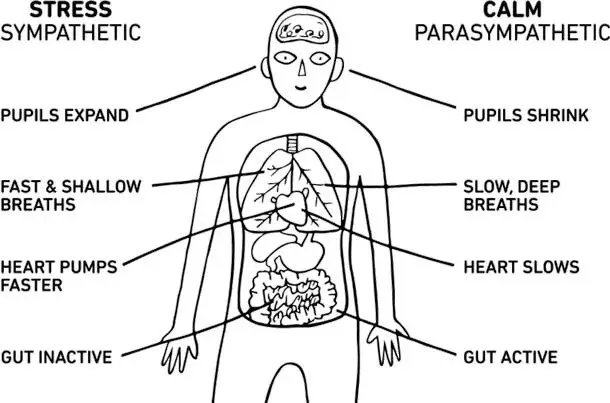Non-sleep deep rest, also called NSDR, is a term coined by Andrew Huberman, a Stanford University neuroscientist best known for his “Huberman Lab” podcast.
Although the NSDR sleep protocol is commonly thought of as a biohacking trend, it has ties to ancient practices like Yoga Nidra.
Non-sleep deep rest combines specialized breathing techniques with mindfulness practices, making it an effective tool for those who struggle to engage with traditional meditation.
That said, a non-sleep deep rest protocol offers a wave of relaxation for experienced meditators and newbies alike.
Non-Sleep Deep Rest vs. Traditional Meditation
Non-sleep deep rest, according to Huberman, received its name to appeal to a new group of people who may not be as open to concepts like meditation or mindfulness.
In an interview with Tim Ferriss, Huberman says, “NSDR is my attempt to create a more friendly language.”
NSDR helps to reset energy levels and focus all without any additional overthinking. With a non-sleep deep rest protocol, you’re essentially listening to and following a script.
Therefore, NSDR is a form of guided meditation, which offers endless benefits for our overall well-being.
Guided meditation and mindfulness practices are proven to reduce stress levels, lower blood pressure, and boost sleep quality.

Chronic stress leads to a rise in inflammation over time. Prolonged stress and elevated cortisol levels are linked to a rise in cytokines, which are commonly thought of as inflammatory markers.
An eight-week study took a closer look at how mindfulness meditation affects inflammatory markers like cytokines. Research revealed that cytokine levels and inflammatory markers decreased after meditation.
What’s more, guided meditation is thought to promote deeper sleep in comparison to those who don’t practice it.
Meditation is proven to increase sleep duration and prevent insomnia when practiced regularly compared to those who don’t have a daily meditation practice as part of their routine.
When it comes to NSDR, sleep perks are just as bountiful. But how, exactly, does NSDR improve our sleep?
NSDR, Sleep, and The Brain
The non-sleep deep rest protocol is famous for promoting relaxation and the onset of sleep. This is no surprise, since NSDR works by slowing down the brain waves in a manner similar to slow-wave sleep.
Slow-wave sleep is one of four sleep phases and acts as the third phase of non-rapid eye movement (non-REM) sleep.
Slow-wave sleep allows for rejuvenation and healing of both the brain and body. During this stage of sleep, more growth hormone is released than in any other phase.
In fact, approximately 95 percent of human growth hormone is produced throughout this stage of sleep.
The release of growth hormone promotes tissue repair, tissue growth, and even enhances and reboots memory and cognitive function.
During both slow-wave sleep and non-sleep deep rest, the parasympathetic nervous system activates. This removes us from the stressed fight-or-flight state, decreasing respiratory rate, heart rate, and stress levels.
Since brain waves mimic slow-wave sleep during NSDR, it serves as a tool that helps mimic the effects of slow-wave sleep that some people may be missing out on due to insomnia or sleep disruptions.
Therefore, a non-sleep deep rest protocol may help improve the general quality of your sleep by helping your brain set the scene for sleep faster than usual.
But that’s not all. Aside from a sleep boost, additional NSDR benefits include:
- Better neuroplasticity, which is the nervous system’s ability to alter itself in response to different experiences, stimuli, and environments
- Improved cognitive function, focus, and mental clarity
- Vagus nerve activation, which enhances vagal tone by signaling to the body that it’s safe to relax
- An increase in positive emotions and a decrease in depression
In summary, a non-sleep deep rest protocol offers a quick, straightforward way to improve both your mental and physical well-being. But how do you practice it?
Practicing Non-Sleep Deep Rest (Huberman Style)
When it comes to practicing non-sleep deep rest, Huberman compares it to two different techniques: Yoga Nidra and hypnosis.
Yoga Nidra, also called Yoga Sleep, involves a guided meditation that helps elicit a sense of relaxation through body scanning.
Body scanning includes taking note of different body parts and relaxing each one one at a time. This brings focus and awareness to the body and away from the mind, quieting anxious thoughts.
@somnifix Non sleep deep rest, or #NSDR 😴, is a form of #yoganidra that involves #bodyscanning & #guidedmeditation for imrpoved neuroplasticity, sleep, & more! #biohack #hubermanlab #learntok #neuroscience ♬ A Day in My Life - Soft boy
Focused breathing is also involved – and the best part is that all you have to do is follow the instructions to enter a state of calm.
Yoga Nidra videos can be found all over the internet. On YouTube, there are varying lengths of Yoga Nidra practices with many different instructors.
Huberman recommends this one by Kamini Desai.
That said, there are many NSDR-specific guided meditations online as well, including a 10-minute one that Huberman leads himself.
Follow along with a non-sleep deep rest protocol in the middle of the day for a quick rest or practice it before bed for enhanced sleep.
However, if you plan to listen to an NSDR sleep meditation before bed, ensure that you’re nasal breathing before you fall asleep.
Otherwise, open-mouth snoring caused by mouth breathing will further fragment and disrupt your rest, regardless of your nighttime routine.
Tape Your Mouth For Deeper Rest
Huberman’s non-sleep deep rest protocol offers a reset that helps the body and brain wind down.
That said, if you don’t keep an eye on your airway function, you’ll cancel out all of the calming benefits of NSDR for better sleep.
Mouth breathing during sleep places the body in a stressed state due to over breathing. Moreover, when we mouth breathe during sleep, airway tissues fall backward.
This leads to snoring which disrupts both your sleep (and your partner’s).

To ensure proper airway function during sleep, we must breathe through our noses – not our mouths.
When we breathe through our nose, it produces nitric oxide known for its calming effects. The nose also warms, filters, and humidifies the air for optimal oxygenation.
There’s just one issue: how do you make sure your mouth doesn’t fall open while you sleep, causing mouth breathing and snoring?
Mouth tape offers a simple solution that ensures nasal breathing and optimal sleep all night long.
Nevertheless, most tapes contain irritating chemicals within their adhesive. That means rashes, irritation, and uncomfortable sleep.
SomniFix, however, was designed with all skin types in mind. Our strips include hypoallergenic materials free from both latex and gluten.
Our gel-like adhesive provides a fit so comfortable, you won’t even realize you’re wearing mouth tape to bed. What’s more, our patented central breathing vent allows for emergency mouth breathing if you experience overnight congestion.
If you’re looking to add a practice like non-sleep deep rest to your lifestyle, tack SomniFix onto your protocol to ensure the highest quality sleep you’ve experienced yet!




